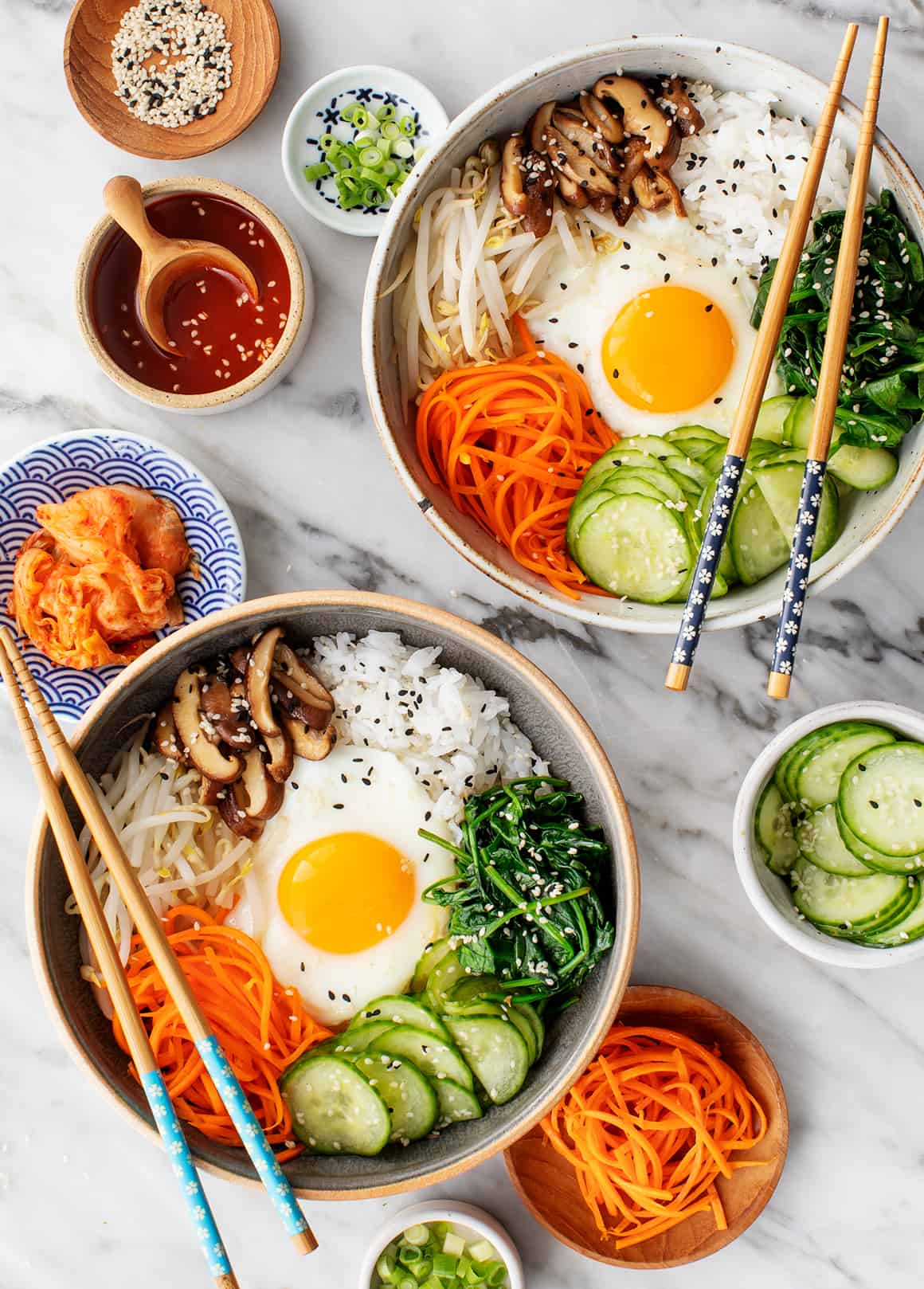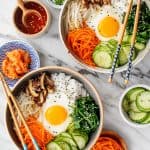This bibimbap recipe will make anyone fall in love with bowl food. When I talk about bowl food, I mean any recipe that consists of a base, such as noodles or rice, a protein, vegetables, and a flavorful sauce. I’ve had my fair share of grain bowls and noodle bowls over the years, but without question, bibimbap is bowl food at its best. If you’ve never heard of bibimbap, it’s a Korean rice bowl topped with assorted vegetables, spicy gochujang, and an egg and/or meat. It’s one of the most well-known Korean dishes, and once you try it, you’ll see why. Each component contributes something essential to the bowl – think richness, heat, or crisp texture. Of course, my bibimbap recipe is meat-free, so it puts the vegetables front and center. Each one is lightly seasoned before it’s added to the bowl, highlighting its unique taste and texture. Combined with warm rice, fiery sauce, and a perfect runny egg, the veggies create a veritable explosion of flavor and texture. If you love veggie-forward dishes that pack a big punch of flavor, this bibimbap recipe is just the thing for you.
Bibimbap Recipe Components
My bibimbap recipe starts with these three traditional components:
Rice – White rice is traditional for bibimbap, but brown rice or cauliflower rice would work here too. A sunny-side up egg – Break the yolk and mix it into the bowl to create a sauce-like coating for the rice and veggies. If you’re vegan, skip the egg, or replace it with baked tofu or tempeh. Gochujang sauce – If one ingredient is the real star of bibimbap, it’s the gochujang sauce. Its spicy, sweet, funky flavor comes from gochujang paste, a fermented red pepper spread that’s commonly used in Korean cuisine. As far as flavor goes, there’s really nothing else like it.
Then, I add the veggies! Bibimbap can be made with a wide assortment of vegetables, so feel free to use what you like. Make a simpler bowl with two or three veggies, or add your favorites. Steamed or sautéed cabbage, bok choy, or daikon would all be great here. Can’t pick? This combination is fantastic:
Cucumber – I thinly slice cucumber and marinate it with rice vinegar and sesame oil to give it tangy, nutty flavor. Bean sprouts – Lightly blanched, they add a delicious crunch to this bowl. Shredded carrots – I lightly sauté them in sesame oil so that they soften just slightly. I use my julienne peeler to cut the carrots here, but if you don’t have one, grated carrots will work just as well. Sautéed shiitake mushrooms – Again, you can make bibimbap with any vegetables, but I especially love the mushrooms here. Tamari and rice vinegar highlight their rich umami flavor. Sautéed spinach – Sesame oil and tamari give it toasty, savory flavor. Make sure to squeeze the excess liquid out of the spinach after you cook it so that your bibimbap isn’t watery.
Assembling and Eating Bibimbap
To make this recipe, start by cooking the rice. While it simmers, whisk together the sauce and prep the veggies. Start with the cucumber so that it has time to marinate. Then, blanch the bean sprouts, and sauté the carrots, mushrooms, and spinach. Last but not least, cook the eggs. Assemble each bowl with a base of cooked rice, and top it with the egg. Place the vegetables in sections around the perimeter of the bowl, surrounding the egg, and drizzle with the gochujang sauce. When you’re ready to eat, break the egg yolk and mix the components together. (Bibimbap translates literally to mixed rice, after all!) The runny egg yolk and sauce will combine to coat the rice and veggies, which makes the bowl really flavorful and fun to eat.
I like to serve my bibimbap with extra sauce, sliced green onions, and kimchi on the side and mix them in as I eat. Feel free to skip these components, or add them to your bowl from the get-go. Again, this recipe is flexible, so customize it to create a bowl you love!
More Rice Bowl Recipes
If you love this bibimbap recipe, try one of these rice bowls next:
Mango Ginger Rice Bowl Tamago Kake Gohan Best Buddha Bowl Kimchi Brown Rice Bliss Bowl Brown Rice and Adzuki Bean Bowl

